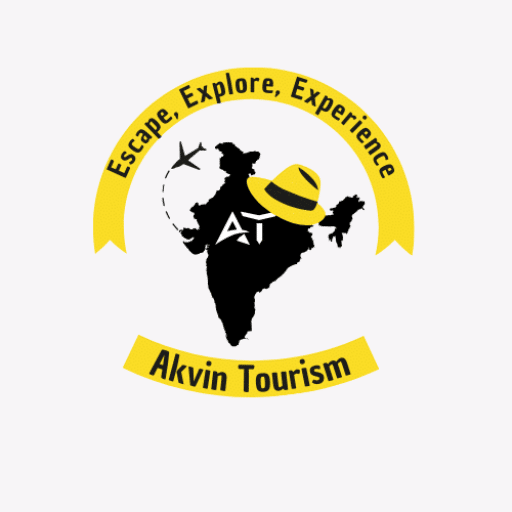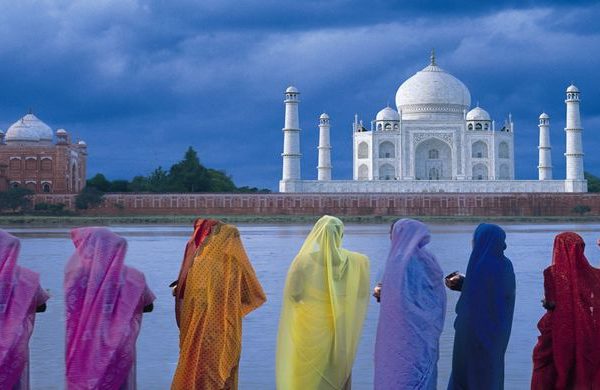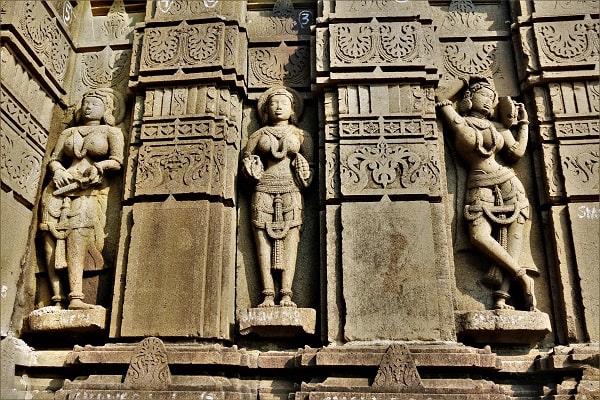Our customer, Romy has decided to share with us her impressions about Aurangabad. You can find her photos on Instagram and contact her on her website
Our customer’s trip: 5th to 8th of March – Aurangabad
After a month of quite touristic travel I had the feeling to finally get to know the authentic India. And since Aurangabad does not (yet) have any hostels anyway, I decided for the first time to use AirBnB at more European prices to stay with an Indian family, with a large single room and breakfast + dinner included. Sometimes you just have to treat yourself.
Discovery of the family
So I end up with Akash, a twentysomething tour guide and his family (mother, father and sister) in a nice and quiet area of Aurangabad. Before I can even see the room, I am welcomed traditionally in the living room with a glass of water, a lunch snack, interested questions about myself and useful facts about family life here.
Then I move into the entire attic floor consisting of a 16m² room with shower, a large terrace and an outside toilet.
After a long nap we continue with tea, talks and finally dinner. There are cereals I can’t even name in German, Dal (lentil sauce), Palak Paneer (Indian cheese in spinach, one of my favourite dishes here), various bread and sweet dumplings. So as usual pure carbohydrates, which remind me of my lack of yoga practice in the last weeks. But I finally learn to eat rice with my hands without looking like I have the body control of a two-year-old and everything tastes just amazing. I have become somewhat accustomed to spicy food, since so-called Western or Continental Food is becoming an expensive exception for me and mostly it does not keep what it promises.
Discovery of the area
After dinner Akash takes me to the nearby Hindu temple, which we visit together with his friends. On the way there he whispers to me “People are staring at you. Tourism is not yet common here, there are no foreign women without foreign men. And certainly not with such short hair.” He smiles. And only then I do notice that everyone on the street actually turns around. Three Indian mid-twenties and a slightly older, significantly taller, tattooed woman with pale skin.Must have looked funny, but I’m used to staring now.
We enter the temple barefoot and touch a black marble turtle, which is embedded in front of the first step, on the head with our right hand, that should bring us luck. Then we ring a bell hanging above the entrance to symbolize the goddess that we are there. And then off to the shrine in front of us. There one does not bow too deeply with the hands in the greeting gesture before the forehead and speaks silently his prayer, wishes or also simply nothing, as I do at this moment, because the impressions are too overwhelming for me to think of anything. Then we touch the shrine again with our right hand and walk through the temple clockwise, thus also again to the right. At the end we exit the building backwards, because you never turn your back to a god here.
And then we just hang out at the temple grounds, I ask 100 questions about gods and cows and the guys answer every question patiently and seem to be happy about my interest. I already knew of the 3 main gods of Hinduism, Brahma, Shiva and Vishnu. But not of their means of transport or seating. Vishnu is sitting on a snake. Brahma on a lotus. And Shiva rides a cow. “Aha. So that’s why they’re sacred?!” “Not only. In Hinduism we also believe that there are altogether approx. 32 billion [short pause for confirming thought] yes correctly, billion gods. And for us they live in cows.
This may sound crazy to you, but that’s why it’s forbidden to inflict any kind of suffering on a cow here. Otherwise you can be sent to prison. And, of course, this also leads to conflicts with Muslims, Christians and the other religions that think differently, but everyone must abide by it, that has been in the law for years”.
Wow. That’s a lot of information for the first night here. As the mosquitoes bother us too much after a while, we go back to the house.
From breakfast to Ajanta caves
On my first morning there is a typical Indian breakfast served at half past seven, which I didn’t know yet: Poha, some kind of flat yellow rice with spices, fresh coriander and roasted peanuts. Super tasty, but for breakfast quite spicy which is still not exactly in my comfort zone to be honest.
Afterwards we drive to the Ajanta Caves together with Akash’s uncle. The caves are actually Buddhist temples, which were probably hew in lava stone in the 2nd century B.C. and developed further over the following centuries. For such a unique destination I skip the famous temples in Hampi, which every backpacker, who holds something on himself, visits his trip to India.
And I’m already being rewarded for this decision at the point where the two of them drop me off: A viewpoint about 20 minutes walking distance from the entrance, from where you stroll along the volcanic crater to the ticket counter and have a great view of the cave complex at all times. From here on I am on my own for a few hours, which doesn’t bother me at all, because extensive explanations would lead to a total overload of impressions at this time. I let the barren, hot area, which waits longingly for the monsoon season, work on me, make my way in all peace and fantasise, what the area looks like after downpours. What a nice idea.
At the ticket counter I can hardly believe my eyes: Locals don’t pay more than 30 rupees, while foreigners pay a whopping amount of 500 rupees. Cheeky! But I’m going to find out that this is a common thing around here. Anyway, India is only once a year, right?!
So I step directly into cave no. 9, from there to cave no. 1 and then all the way to cave 26 without leaving one out. I admire ancient wall paintings, carvings, huge sculptures, columns, statues and so on. In one of the biggest caves I hold my breath when I hear a dozen women and children chanting their prayers on the floor in front of the Buddha statue. How fortunate to be here at this very moment. In another, longer cave reminiscent of the interior of a ship’s hull, a tour guide shows his singing skills in order to demonstrate the special acoustics of this room. Here my tears are almost rising in my closed eyes. I don’t know why these tones touch me so much, but I certainly won’t forget them too soon.
After 4 hours Akash and the uncle pick me up again and I tell them enthusiastically about my impressions over a glass of fresh sugar cane juice at the roadside on the way back. Both agree that I will not be less impressed by the goals of the next day.
Khuldabad and Ellora caves
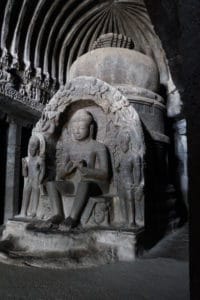
Ellora caves
In the morning we drive to Khuldabad, a village that is exclusively inhabited by Sufis and where you find Tombs and mosques to marvel at. Here Akash explains to me again a few principles of Islam and Hinduism and thus also of their mixed form, Sufism. We visit Mughal tombs, where I learn a lot about the history of India, then we go to the Sufi community where a man in a white robe blesses us with a peacock feather frond and tells us even more about the history of the Sufi.
So the whole super informative morning continues until I am dropped off around noon at the Ellora Caves, which are -like the Ajanta Caves- UNESCO world cultural heritage. But unlike the day before, besides numerous Buddhist caves, also Hindu and Jaina temples await me here. All carved into the same crater and resembling the Lost City from the Jungle Book.
And again: WOW! Not only the spectacular scenery impresses me on this day, but also the fact that I visit places for prayer of 5 religions in only one day, which are all built almost directly next to each other. And all of them are perfectly preserved according to the weather conditions and that radiate peace. For me it symbolizes what I have felt almost everywhere on my journey so far: India is filled with religion, there are almost no atheists here and if there are, they are at my age or younger and live in big cities, but all live side by side with each other. At least on the whole. Of course, one can feel clear differences in mentalities, but the tolerance threshold seems to be very high.
Last day in Aurangabad
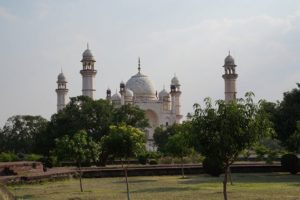
Bibi ka Maqbara
All this has to be processed first, so I don’t do much on the third and last day before I take the night bus to Mumbai in the evening. But what I can’t miss is the ultimate foretaste of the Taj Mahal, the Bibi Ka Maqbara, which is known as “Mini Taj” or “poor man’s Taj”, because it resembles the world-famous building very strongly, but is much smaller. The story is controversial, but what is certain is that the construction must have cost a tiny fraction of the tourist magnet in Agra. It’s not really busy at lunchtime which is nice. I am hardly asked for selfies and can take some nice snapshots. Actually, no wonder at 38°C. Hopefully Mumbai, or Bombay as it used to be called, will be a little more pleasant in terms of weather…
